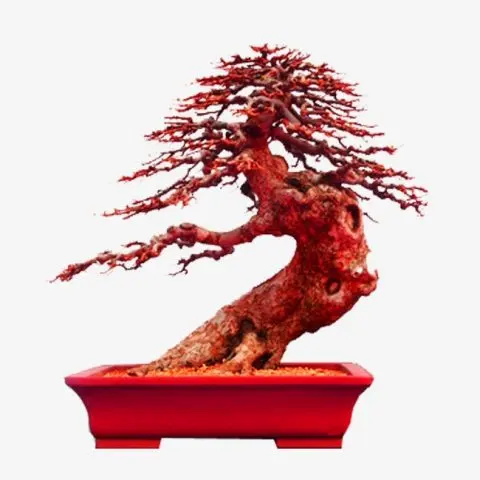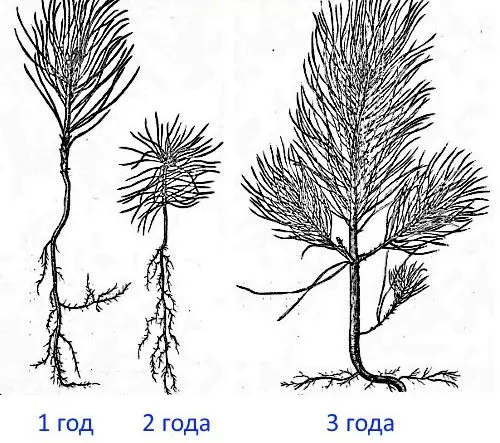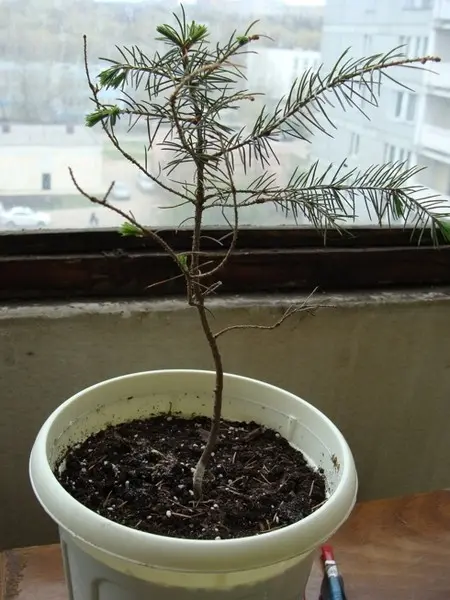Contents
Many dream of planting and growing coniferous plants at home, filling the room with useful phytoncides. But most conifers are residents of temperate latitudes, and dry and rather hot living conditions are categorically not suitable for them. Of course, a pine tree in a pot can look no less exotic than any palm tree. But, choosing a suitable plant, it is necessary to understand that it must at least come from subtropical latitudes. In this case, there is some chance of success, provided that a suitable wintering ground is provided.

Which pines are suitable for growing in a pot
Pine is one of the most familiar coniferous trees for the inhabitants of temperate latitudes, which, by its very appearance and aroma, can cheer up and give strength. Evergreens can help reduce depression during a long, cold, dark winter. But, the main problem is that the main green inhabitants of the rooms come from tropical latitudes, where it is warm and the sun shines all year round. Pine, on the other hand, is a northern tree, and even its southernmost varieties are accustomed to a significant seasonal drop in temperature. Therefore, it is best to provide a balcony, terrace or veranda for growing pine in a pot.
In addition, Scotch pine and many of its other species are large trees, reaching many tens of meters in height. For keeping in pots, its dwarf varieties are best suited, which, even in adulthood, rarely exceed 1 m in height. Some bushy or creeping species are also suitable. In addition to their small size, they also have an often slow growth rate, which is ideal for potting conditions. Since transplantation is a very traumatic procedure for any coniferous tree.
So, if the task is to grow a pine tree in a pot, then you should choose from subtropical species of dwarf varieties.
In the modern assortment, the choice of such plants is quite wide. Below are the most popular varieties of pines more or less suitable for growing in pots:
- Bosnian (variety Smidtii) – a dwarf variety of spherical shape.
- Mountain (grade Pumilio) – an elongated bush of small height.
- Mountain (WinterGold variety) – a variety of miniature conifer, the needles of which change their color depending on the season from light green to golden yellow.
- Weymouth (variety Radiata) is a slow growing dwarf variety, which only after 10 years reaches 80 cm in height.
- Spinous – a variety growing in a bush, adds no more than 10 cm in height in a year.

How to plant a pine tree at home in a pot
For planting and subsequent cultivation of pine in a pot at home, you can:
- grow a young tree from seeds yourself;
- purchase a ready-made seedling in a store, in a nursery or from private individuals.
The first option is suitable for those who are truly passionate about plants, since growing from seeds is a very painstaking process, requiring a lot of time and especially patience.
The second option is simpler, and suitable for anyone, subject to some basic rules for choosing and planting trees.
Preparation of the planting tank and soil
When choosing a container designed for growing young pines, you need to focus on their age. Very young plants take root best of all, aged from 1 to 3 years. But in such pines, side branches are usually not even formed yet. It is at the age of three that the first whorl (branching) usually appears on the pine.

Such seedlings are rarely found in nurseries and even more so in stores. They are usually sold only by individuals who grow pines from seeds.
In nurseries and shops, as a rule, you can find pine seedlings, starting from 5-7 years of age. They need pots of a larger volume, from 1 to 3 liters.
Regardless of the size of the pots for planting, drainage holes must be made in them. Since pine seedlings do not tolerate stagnant moisture. At the bottom of any container, it is necessary to lay drainage from expanded clay or ceramic fragments. The drainage layer should be at least ¼-1/5 of the volume of the pot.
You should also approach the choice of soil for growing pines in pots very responsibly. Due to its small volume, it should be quite nutritious, but at the same time light, loose and water- and air-permeable. Under natural conditions, pines grow mainly on sandy soils, but in a pot, the sand will dry out too quickly and will not be able to retain enough nutrients. Therefore, it is best to use a mixture of 50% high-moor peat, 25% sand and 25% humus (or humus soil).
Often in stores you can buy a ready-made soil mixture for growing coniferous plants. It is quite suitable, since it is initially characterized by a moderately acidic environment (pH 5,5-6,2), which is ideal for pines.
Since pines, especially young ones, are very sensitive to fungal diseases, it is recommended to shed the earth with a weak solution of potassium permanganate or water with phytosporin before planting.
Preparation of planting material
It is best to purchase pine seedlings in containers with an earthy clod. Since even the exposure or drying of the roots for 5-10 minutes can lead to the fact that the young seedling will get sick for a long time or die. For this reason, when transplanting, they try to minimally disturb the earthen ball surrounding the roots of a pine seedling. Another reason is that in the soil immediately adjacent to the roots there are many substances useful for them, such as mycorrhiza, without which the roots will hardly take root in a new place. And, of course, an earthen ball during transplantation should not be overdried or waterlogged. Soil moisture should be optimal, at which water does not flow from a clod of earth, but it does not disintegrate when compressed.

Rules of landing
Planting an acquired pine seedling does not present any particular difficulties, since it is rather a transshipment, while the root system is practically not affected.
A pine seedling, together with a clod of earth, is simply pulled out of the container and placed in a hole prepared for it in a new pot. The landing depth level must completely match the previous one. If there is even the slightest doubt, it is better to plant a pine tree a little higher, but in no case deepen it.
Then the soil around the seedling is compacted and, if necessary, a little earth is added.
When caring for a pine tree in the house, it should be provided with the most sunlit place. But in the first two weeks after transplantation, it is better to lightly shade the young tree so that it takes root well.
Transfer
Every 2-4 years, depending on the growth rate of the selected variety, pine trees need to be transplanted into a larger pot with a mandatory drainage layer.
How to grow a pine tree at home in a pot
Pine care at home is not so difficult if you provide the tree with suitable living conditions. But with this there can be certain problems. After all, conifers, including pines, do not tolerate the dry and warm air of ordinary residential premises. And in winter, they do need relative cold, which is difficult to create in a living room.
How to water pine trees in pots
The soil in which the pine is planted should be slightly damp all the time. Trees are equally negative about both waterlogging and overdrying of the substrate. The needles from them in these conditions begin to crumble, and it is not always possible to save them.

Therefore, in caring for a pine tree at home, watering is of decisive importance. It should be regular and carefully measured depending on weather conditions. If the bright sun shines and the earth can dry out quickly, you need to water every day. In cloudy or cold weather, you can limit yourself to watering 1-2 times a week.
At the same time, the composition of water, the degree of its hardness and temperature are of no particular importance. It is best to water not with a strong jet, but gradually, using a spray bottle. Moreover, when caring for a pine tree in an apartment, it can only survive with daily spraying.
You can also apply the method of watering from below, when a wick is inserted through the drainage holes and placed in a pan filled with water. In this case, the tree itself will use as much water as it needs for some time.
How to feed indoor pine
Fertilizers for pines growing in a pot are best used to a minimum. Pine trees should be watered twice a season with the addition of a root stimulator.
In the first year after planting, a young seedling practically does not need additional feeding. Especially if quite nutritious land was used.
Caring for a pine in a pot requires the use of a special complex fertilizer for conifers about 2 times a year. When used according to the instructions, it must be additionally diluted 2 times, since the concentration is designed for trees growing in open ground.
Protection against diseases and pests
In pot growing conditions, most often pine can be affected by various fungal diseases. For prevention purposes, once a month, phytosporin or foundationol must be added to the water for irrigation.
Pests rarely attack a pine in a pot. But if this nevertheless happened, then it is better to use a biological insecticide – phytoverm – to protect the tree.
Wintering live pine in a pot
Winter is perhaps the most difficult period for pine growing at home. In a hot and dry room, she will not survive unequivocally. In order for a tree to overwinter normally, it needs to provide a lot of light and a temperature from 0 ° C to + 10 ° C. Usually, these conditions are easy to meet on a glazed balcony or loggia, where an electric heater can be turned on in the most severe frosts.
If there is no heater, then it is necessary to protect the roots from frost. Since the layer of earth that is in the pots is not enough so that the roots do not freeze. To do this, they are usually lined with polystyrene or polystyrene, and all internal gaps are filled with leaves, sawdust or straw. On particularly frosty days, the aerial part of the plants can be covered with transparent agrofibre, which transmits light, but protects from low temperatures and from drying out.
If it is not possible to provide coolness to the pine in winter, then it is better to transplant the tree into the garden as soon as possible. Since it will not survive for more than one year in such conditions.

gardening tips
Pine has never been a houseplant, so caring for a home tree will require maximum observation and a path full of possible trial, disappointment and error.
Perhaps the following recommendations from gardeners can help along the way:
- Mature pine trees need plenty of sunlight, while young seedlings may be more sensitive to it. During the hottest hours, they may need some shade.
- If it is impossible to provide the necessary decrease in temperature in winter, the pine tree must be provided with maximum air humidity. True, it should be borne in mind that a humid and warm environment is an excellent breeding ground for fungal infections.
- If, after transplanting, the pine needles began to turn yellow, the roots may have been dried. The tree in this case is very difficult to save. You can try to place it in the most cool and light conditions.
- Yellowing of the needles in the lower part of the trees may also be due to a lack of light or too plentiful top dressing.
- Ordinary artificial light in no way replaces the sun. Because it lacks the ultraviolet rays necessary for normal photosynthesis. Because of this, the growth of pine can be greatly inhibited.
- In the autumn period, the loss of some part of the needles is almost normal for a pine, you should not be afraid of this.
Conclusion
Pine in a pot is not yet a very familiar sight for conditions. But if you have some reserve of enthusiasm, then everyone can cope with growing a tree at home. You just need to follow all the recommendations described in the article.









